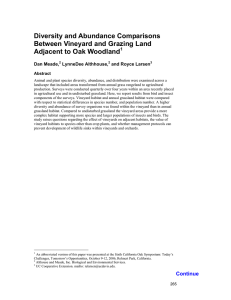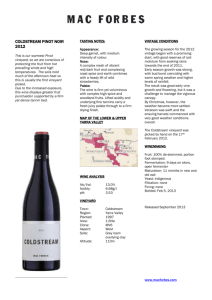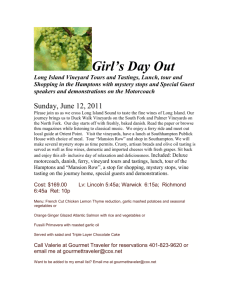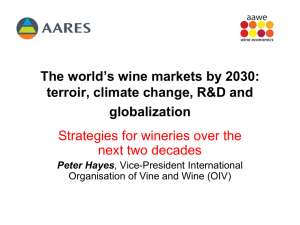The Value of Terroir: Hedonic Estimation of Vineyard Sale Prices
advertisement
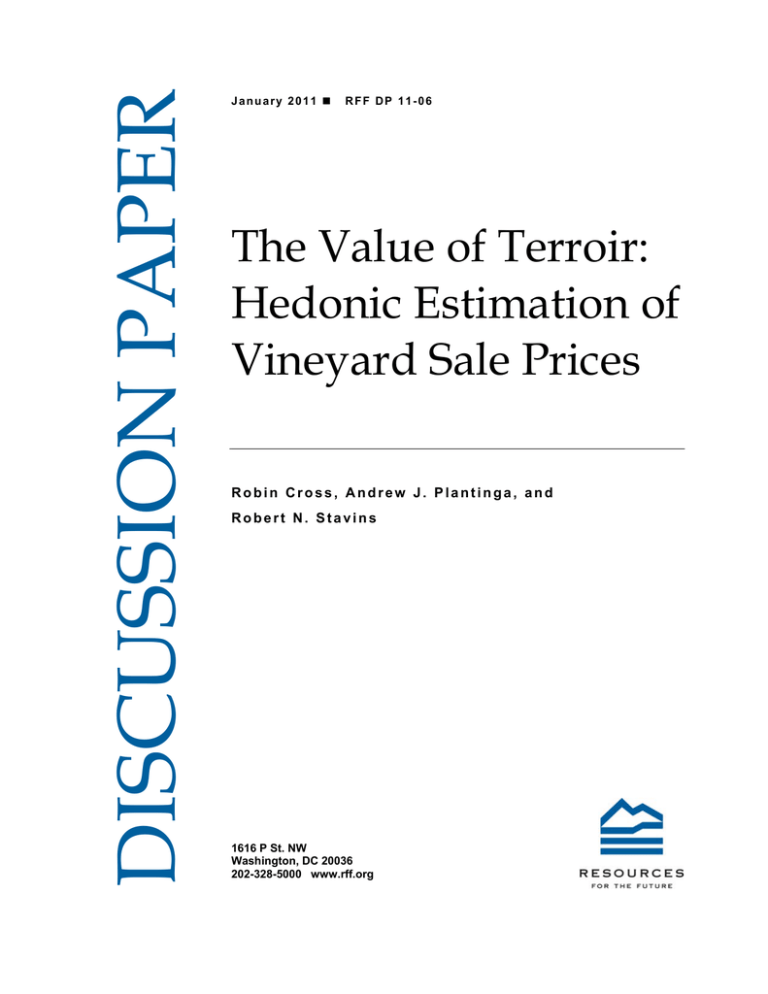
DISCUSSION PAPER January 2011 RFF DP 11-06 The Value of Terroir: Hedonic Estimation of Vineyard Sale Prices Robin Cross, Andrew J. Plantinga, and Robert N. Stavins 1616 P St. NW Washington, DC 20036 202-328-5000 www.rff.org The Value of Terroir: Hedonic Estimation of Vineyard Sale Prices Robin Cross Oregon State University Andrew J. Plantinga Oregon State University Robert N. Stavins John F. Kennedy School of Government, Harvard University National Bureau of Economic Research Resources for the Future January 20, 2011 Send Comments to: Prof. Andrew J. Plantinga Department of Agricultural & Resource Economics Oregon State University Corvallis, OR 97331 Phone: 541-737-1423 Fax: 541-737-1441 E-mail: plantinga@oregonstate.edu The Value of Terroir: Hedonic Estimation of Vineyard Sale Prices ABSTRACT We examine the value of terroir, which refers to the special characteristics of a place that impart unique qualities to the wine produced. We do this by conducting a hedonic analysis of vineyard sales in the Willamette Valley of Oregon to ascertain whether site attributes, such as slope, aspect, elevation, and soil types, or designated appellations are more important determinants of price. We find that prices are strongly determined by sub-AVA appellation designations, but not by specific site attributes. These results indicate that the concept of terroir matters economically, although the reality of terroir – as proxied for by locational attributes – is not significant. JEL Classification: C2, Q11 Key Words: wine, vineyard, hedonic price analysis The Value of Terroir: Hedonic Estimation of Vineyard Sale Prices Robin Cross, Andrew J. Plantinga, and Robert N. Stavins* Wine producers and enthusiasts use the term “terroir,” from the French terre (meaning land), to refer to the special characteristics of a place that impart unique qualities to the wine produced. The Appellation d’Origine Contrôlée (AOC) system in France, and similar systems adopted in other major wine-producing countries, are based upon the geographic location of grape production, and are therefore predicated on this notion of terroir. Under a parallel U.S. system, production regions are designated as American Viticultural Areas (AVAs), with finer geographical designations known as sub-AVAs. Such designations allow wineries to identify the geographical origin of the grapes used in producing their wines, and -- equally important – seek to prevent producers outside the AVA from making false claims about the nature and origin of their wines. What is the value of terroir in the American context? Does the “reality of terroir” – the location-specific geology and geography (including climate) – predominate in determining the quality of wine? Does the “concept of terroir” – the location within an officially named appellation – impart additional value to grapes and wine? More to the point, does location within such an appellation impart additional value to vineyards? The central question we address is whether measureable site attributes – such as slope, aspect, elevation, and soil type – or appellation designations are more important determinants of vineyard prices.1 We do this by conducting a hedonic price analysis to investigate sales of vineyards in Oregon’s Willamette Valley, one of the most important wine-producing regions in the United States.2 How should site attributes and sub-AVA designations influence vineyard prices? If site attributes significantly affect wine quality and if consumers are able to discriminate such quality, then vineyard prices would depend on site attributes alone,3 and AVA designations would be * Cross and Plantinga are Postdoctoral Research Associate and Professor, respectively, in the Department of Agricultural and Resource Economics at Oregon State University; and Stavins is the Albert Pratt Professor of Business and Government at the John F. Kennedy School of Government, Harvard University, Research Associate of the National Bureau of Economic Research, and a University Fellow of Resources for the Future. The authors are grateful to Charles Mason, Larry Lev, and session participants at the 2009 American Association of Wine Economics and 2011 Allied Social Science Association meetings for helpful comments on a previous version of this paper (Cross, Plantinga, and Stavins 2011), but all remaining errors are their own. 1 The notion of terroir sometimes extends beyond natural endowments to encompass the history and culture of a place, but we use a narrower and more common definition of terroir focused on physical attributes of the location (Gergaud and Ginsburgh 2010). 2 The Willamette Valley is designated as an AVA. Within the valley, there are six sub-AVAs: Chehalem Mountains, Yamhill-Carlton District, Ribbon Ridge, Dundee Hills, McMinnville, and Eola-Amity Hills. 3 Wine quality is affected not only by site attributes, but also by the quality of growing stock, as well as vineyard management, and the skills and resources of the winemaker. 3 redundant. Alternatively, consumers might not be able to discriminate among wines perfectly and might use AVA designations as signals of average quality of wines from respective areas, and/or might derive utility directly from drinking wines which they know to be of particular pedigree. In this intermediate case, site attributes and AVA designations would influence vineyard prices, with the variables for site attributes measuring how producers value intra-AVA differences in vineyard characteristics. Presumably, producers attach premiums to site attributes that enhance wine quality, provided that consumers can perceive and are willing to pay for such quality differences. What if, at the extreme, variation in vineyard prices is explained completely by AVA designations (that is, site attributes are irrelevant)? This would indicate that terroir matters economically – as a concept, though not as a fundamental reality. Producers might recognize the value of the AVA designation because they know that consumers will pay more for the experience of drinking wine from designated areas.4 But the fact that site attributes are unimportant suggests that consumers cannot discern quality differences. Any appreciation they might express for an area’s terroir would essentially be founded on reputation, not reality. In the next part of the paper, we discuss some related research from the wine economics literature. Then, in section 2, we describe the data we employ, as well as our estimation strategy. In section 3, we present our results plus some robustness checks. Section 4 concludes. 1. Previous Literature Our analysis is related to and builds upon previous work by others. In one recent study, Gergaud and Ginsburgh (2008) find that site attributes of vineyards in the Haut-Médoc appellation in Bordeaux have no effect on wine prices or ratings, after controlling for producer differences in wine-making technology. Our study builds on this work by examining – in addition to site characteristics – the value assigned to appellation designations. Further, we are able to measure site characteristics more precisely than Gergaud and Ginsburgh by using GISbased information to develop highly detailed physiographic profiles of each parcel. In another recent study, Ashenfelter and Storchmann (2010) investigate the effects of climate on vineyards in the Mosel Valley. As in our study, the authors have fine-scale data on vineyard characteristics. They find that site characteristics – including slope, orientation, soil types, soil depth, and altitude – as well as solar radiation are significant determinants of vineyard quality. We do not include climate variables in our analysis, because of trivial variation in rainfall, humidity, and wind across the relevant portion of the Willamette Valley, but our site attribute variables proxy for the amount of solar radiation received by vineyards. An important similarity and difference with our study concerns respective dependent variables. Gergaud and Ginsburgh (2008) and Ashenfelter and Storchmann (2010) employ measures that are based on wine prices or ratings. Our dependent variable, vineyard sale prices, is preferable in the context of our investigation into the value of terroir, because it avoids 4 Alternatively, buyers might be less informed than sellers about how vineyard attributes affect wine quality, and, therefore, use the AVA designation as a signal of quality. Or producers may bid up the value of vineyards located in designated appellations because there is prestige associated with owning vineyards in such areas. 4 potentially confounding influences on our results of non-vineyards inputs into wine production (such as labor and wine-making techniques). Provided that these inputs are variable and reproducible, profit-maximization implies that the optimal levels of these inputs are implicit functions of fixed and non-reproducible vineyard attributes and input and output prices that are constant across the vineyards in our sample. As such, we can estimate the implicit prices of vineyard attributes using a simple hedonic equation for vineyard sales. As we suggest above, if consumers have limited information about specific vineyards or are unable to judge differences in quality among wines, then they might use appellation designations as signals of quality of wines from respective areas. In fact, the results of many blind taste tests indicate that wine consumers have very limited ability to distinguish intrinsic qualities of wine (sweetness, acidity, tannins, etc.), and instead judge quality by relying on extrinsic signals, such as price, origin, and wine-maker reputation. For example, Veale and Quester (2008) found that tasters’ perceptions of quality were strongly correlated with price and country of origin, but not with intrinsic qualities related to taste. Similarly, Goldstein et al. (2008) found that when price information is withheld, nonexpert tasters show no preference for more expensive wines and even show a slight preference for less expensive wines.5 2. Data and Estimation Strategy 2.1 Dependent Variable for Hedonic Estimation: Vineyard Value In order to investigate the relationship between vineyard sales prices, site attributes, and appellation designation, we employ a new data set on vineyard sales provided by Northwest Farm Credit Services, a lending institution specializing in agriculture. The database includes the universe of 104 sales between 1995 and 2007 of properties in the Willamette Valley that included vineyards and vinelands.6 In addition to total sale price, size, and location of property, sales records include an appraiser’s estimate of the value of non-vineyard assets, such as dwellings and other buildings, winery equipment, and non-vineyard land. We subtract the estimated values of these non-vineyard assets from the total sale price to obtain the value of vineyards in each sale. A remaining complication is that vineyards differ in terms of grape varietals planted, whether rootstocks are resistant to phylloxera, and type of trellis system in place. This heterogeneity accounts for some portion of the difference in sale prices. Because terroir relates 5 Tasters with some wine training demonstrated a non-negative relationship between price and enjoyment. However, Hodgson (2009a, 2009b) has found that even wine judges have difficulty consistently evaluating wines. Using data on over 4,000 wines entered in 13 competitions, Hodgson (2009a) found that the probability of winning a Gold medal in one competition was statistically independent of winning a Gold medal in another competition. Further, Hodgson (2009b) found that judges at the 2009 California State Fair commercial wine competition were inconsistent in their evaluations. 6 Vinelands are areas that can be developed for vineyards. We use the term “vineyards” to refer collectively to vineyards and vinelands. 5 exclusively to non-transferable attributes of vineyards, such as soils, elevation, slope, and climate, we also subtract from the vineyard value the appraiser’s estimate of the value of all vineyard enhancements. This leaves us with the estimated price of bare land for vineyards. After converting these values to 2007 dollars using the Consumer Price Index, and dividing by the area of vineyards, we obtain the real per-acre vineyard value for each property, denoted vinevalue. The log of this variable is the dependent variable in our hedonic model. 2.1 Vineyard Attributes The sales records from Northwest Farm Credit Services provide information about average characteristics of vineyards included in each sale. We develop more precise measures, using GIS-based information on slope, aspect, elevation, and soils. The location of each parcel is determined from tax lot boundaries and matched to GIS maps of physiographic variables.7 Parcels are divided into 10-meter pixels and each pixel is classified according to 14 slope, 16 aspect, 86 elevation, and 8 soil group categories. For example, slope categories are 2-4 degrees, 4-6 degrees, and so forth. Elevation categories are 150-159 feet, 160-169 feet, and so on. Because the number of categories exceeds the number of observed sales, we combine them following conventional wisdom about which vineyard attributes are most favorable or unfavorable.8 We then compute the percentages of each parcel in each of these aggregated categories, and use these as independent variables in our hedonic regressions. The definitions of all variables are found in Table 1. As discussed above, the elevation, slope, and aspect variables determine the amount of solar radiation received at each site and, thus, are proxies for one important component of climate. We did not include additional controls for rainfall, humidity, and wind because these factors exhibit little variation within the Willamette Valley. We conducted sensitivity analyses on the site attribute variables. Because there are other reasonable ways to specify the categories discussed above, we explored alternative definitions, and found that our results were not sensitive to these changes. Another issue with the site attribute variables is that they are defined for the entire property, not only the vineyard portion of the parcel. Unfortunately, we cannot refine these measures, because we do not know exactly 7 The tax lot information was obtained from county tax assessors’ offices. Contour information was derived from USGS National Elevation Dataset data at 10 and 30 meter scales (http://seamless.usgs.gov/ned1.php). Soil information came from the USDA/NRCS Soil Data Mart (http://soildatamart.nrcs.usda.gov/). 8 We define three elevation variables: best (250-450 feet), possible (200-250 feet, 450-650 feet), and too low or too high (<200 feet, >650 feet), denoted bestelev, posselev, and lowhighelev, respectively. Vineyards that are too high or too low face greater risk of frost and low temperatures that inhibit ripening. South-facing slopes are regarded as preferable. We define the aspect variables as south (south), southeast or southwest (southew), east or west (eastwest), and north (north). Jory-Nekiah and Willakenzie-Hazelair are considered the best soils for producing pinot noir, and so we define bestsoil as the share of the parcel with either of these soils. The two other soil variables are goodsoil (Amity-Dayton, Bellpine, Laurelwood, or Yamhill soils) and poorsoil (Willamette-Woodburn and other soils). Finally, vineyards that are too flat (<2 degrees) tend to be poorly drained and those that are too steep (>12 degrees) are difficult to harvest. We define bestslope as the percentage of the parcel with slopes between 2 and 12 degrees and flatsteep as the residual. 6 where vineyards are located within parcels. Instead, we conduct two robustness tests, discussed below, to explore whether our results are affected by this measurement error. For this purpose, we construct a variable, denoted percentvine, measuring the percentage of the parcel in vineyards. In addition to the site attribute variables, we construct a variable for the area of the vineyards (vineacres) and indicator variables for the location of a parcel within a sub-AVA (eola for Eola-Amity Hills, mcminnville for McMinnville, yamhill for Yamhill-Carlton, dundee for Dundee Hills, chehalem for Chehalem Hills, and nosub if the parcel is outside these sub-AVAs).9 Parcels outside of sub-AVAs are demarcated as being in the Willamette Valley AVA. It is important to acknowledge that, although the Willamette Valley AVA was established in 1984, the sub-AVA designations were not officially adopted until 2005 and 2006. Prior to this time, the areas that would later be designated as sub-AVAs were well recognized by wine producers, and it was common practice to label the origin of wines using the same geographical terms.10 We construct a variable, saledate, equal to 1 if the sale occurred after the respective sub-AVA designation became official and 0 otherwise, and use it to test for changes in the effects of the sub-AVA designation. Finally, for use in robustness tests, we computed the straight-line distance from each parcel to the nearest sub-AVA. This variable, denoted distancesub, equals 0 if the parcel is within a sub-AVA. Summary statistics for all variables are presented in Table 2. The average unlogged price for vineyards (vinevalue) is about $10,000 per acre, with prices ranging from $2,500 to $42,000 per acre. Given that our sample includes only parcels with vineyards, we must have withinsample variation in site attributes if we hope to measure effects of terroir. The statistics in Table 2 reveal that 31.3, 47.0, 34.5, and 87.3 percent of the land within our sample of parcels, respectively, faces directly south, and has the best elevation, soils, and slopes. At the other extreme, 16.8, 15.8, 35.0, and 12.7 percent of the land, respectively, is in the least desirable categories for aspect, elevation, soils, and slope. With the possible exception of the slope variable, these statistics suggest that our sample reflects a significant range of physiographic conditions. 3. Results and Robustness Tests For our basic model, we regress the log of vinevalue on vineacres, the square of vineacres (sqvineacres), site attributes, sub-AVA designations, and a constant term. The omitted variables are lowhighelev, north, poorsoil, flatsteep, and nosub. Because these are the least desirable categories, we expect the coefficients on the included site attribute and sub-AVA variables to be positive. The results, in Table 3, reveal that most of the estimated coefficients on the site attribute variables are positive, but none are significantly different from zero. The smallest p-value is 9 We have no observations of sales within the Ribbon Ridge sub-AVA. 10 For example, in 2004, Archery Summit labeled their Red Hills Estate wine “Dundee Hills Pinot Noir.” 7 0.311, and none of the estimates are even marginally significant.11 In contrast, four of the five estimated coefficients for sub-AVA are significantly different from zero at better than the 1% level. Parcels within the Eola-Amity Hills, Yamhill-Carlton, Dundee Hills, and Chehalem Hills sub-AVA sell for significantly more than parcels without a sub-AVA designation. In 2007 dollars, the premiums associated with location within these sub-AVAs were, respectively, $2,933, $3,721, $7,163, and $3,306 per acre. Pairwise F-tests indicate that the coefficient on dundee is different from those on eola, yamhill, and chehalem, but that the coefficients on eola, yamhill, and chehalem are statistically indistinguishable from one another. The coefficients on parcel size indicate that the per-acre price falls as the parcel size increases, but at a diminishing rate. Finally, the adjusted R2 is 0.422, reasonably high for cross-section data. As mentioned above, the sub-AVA designations did not become official until 2005 and 2006. For the Eola-Amity Hills, Yamhill-Carlton, and Dundee Hills sub-AVAs, our sample includes sales that occurred before and after the official designation. To test for a corresponding shift in the sub-AVA premium in these cases, we interact eola, yamhill, and dundee with saledate and add these variables to the basic model. We find that the coefficient estimates are positive and significant in all cases, indicating a rise in the premiums following the official adoption of the sub-AVAs.12 Why are the impacts of site attributes on sales price insignificant? As mentioned above, the site attribute variables are measured over the entire parcel, not just the vineyard portion, which may decrease the precision of these variables and explain why the estimated coefficients are not significantly different from zero. To explore this possibility, we restrict the sample to parcels that are at least 50 percent vineyards (percentvine ≥ 0.50). For the entire sample, an average of 68 percent of the parcel area is vineyards, with a minimum of 16 and a maximum of 100 percent (Table 2). With a 50 percent cut-off, we still have 83 observations with which to estimate the model. The results (not reported, but available upon request) show little change from the basic model. None of the coefficient estimates for site attributes are significantly different from zero, and the estimates for sub-AVAs have similar magnitude and significance level. Qualitatively, the findings remain the same for cut-off values of 68% and 75%. We also re-estimate the basic model with percentvine entered as an independent variable in the basic model. The associated coefficient is not significantly different from zero. Another possible explanation for the insignificance of the site attribute variables is that their effects could be masked by the sub-AVA designations. The sub-AVA designations are supposed to be based on the area’s terroir. In this case, the sub-AVA variables would measure the average effect of the site attributes of parcels within the sub-AVA, and dropping the subAVA variables would increase the explanatory power of the site attributes. We find this result in 11 The results do not change appreciably if we use robust standard error estimates. 12 The Eola-Amity Hills premium increases from $590 to $5,621 per acre, the Yamhill-Carlton premium increases from $2,186 to $7,064 per acre, and the Dundee Hills premium increases from $4,440 to $15,474 per acre. The full set of results is available from the corresponding author upon request. 8 the case of the bestsoil variable, which has a positive and significant (5% level) coefficient when we omit the sub-AVA variables (Table 4). Further investigation reveals that the bestsoil variable is highly correlated with the indicator variable for the Dundee Hills sub-AVA (dundee) but not with the other sub-AVA variables.13 Thus, the model in Table 4 does not identify whether higher vineyard prices are the result of soils or location within the Dundee Hills sub-AVA. We split the sample into two groups – parcels inside and outside the Dundee Hills sub-AVA – and estimate separate models with only the site attribute variables. In both cases, the coefficient on the bestsoil variable is insignificant, suggesting that it is the Dundee Hills location, and not better soils, that raises vineyard prices.14 A further check is to see if there is variation in the site attributes within sub-AVAs. If not, then the effects of the site attributes will be captured by the sub-AVA variables. Table 5 reports the standard deviation of the site attributes for the whole sample and for parcels within each sub-AVA. The statistics indicate similar variation in site attributes within and across subAVAs. Finally, if the terroir of a sub-AVA has important influences on wine quality, then parcels that are outside, but close to, sub-AVAs should be valued more than parcels that are farther away. We re-estimate the basic model with the variable distancesub included. This corresponding p-value is 0.45.15 Our results indicate that the significant premiums associated with sub-AVA designations are unrelated to observable site attributes. An alternative explanation is that bottle prices for wines from sub-AVAs command higher prices (for reputational reasons), which bids up the prices of sub-AVA vineyards. To examine this possibility, we summarized data on 2006 Pinot Noir bottle prices for the Willamette Valley AVA and for each sub-AVA. From the Wine Spectator database, we obtained 243 observations, and from the Wine Advocate (Robert Parker) database 310 observations. In Table 6, we report the vineyard premiums (in 2007 dollars), based on the results from Table 3, plus the average bottle prices (in 2007 dollars) from our two wine data sources. The rankings of vineyard premiums are broadly consistent with bottle rankings. McMinnville and Willamette Valley are at the bottom in all rankings and Dundee Hills is at or second from the top. Of course, the bottle prices are also affected by the skills and reputations of 13 The simple correlation coefficient for bestsoil and dundee is 0.69. 14 There are 24 parcels inside the Dundee Hills sub-AVA and 80 parcels outside. With these sub-samples, the pvalues for the bestsoil variable are, respectively, 0.81 and 0.90. Although the mean of bestsoil is higher for parcels inside the Dundee Hills sub-AVA (0.87 compared to 0.19), there is considerable variation in the bestsoil variable within the sub-samples. In both cases, bestsoil has a standard deviation of about 0.30 and minimum and maximum values of 0 and 1, respectively. 15 A similar result is obtained when we drop two observations for parcels that are outside but closest to the McMinnville sub-AVA. There is no premium associated with being inside this sub-AVA. Full results are available from the corresponding author upon request. 9 wine-makers, and so these results are, at most, suggestive of correlation between vineyard and bottle prices.16 4. Conclusions We have estimated a hedonic model of vineyard prices in Oregon to examine whether they vary systematically with designated appellation, after controlling for site attributes. Despite using precise measures of site attributes, we do not find evidence of a significant effect of these variables on vineyard prices, and a series of robustness tests does not alter this finding. But, we do find that vineyard prices are strongly determined by whether or not parcels are inside specific sub-AVAs. The delineation of sub-AVAs is intended to capture the unique characteristics of a geographical area as they relate to grape production.17 That is, sub-AVAs are supposed to reflect the area’s terroir. Our finding that the physical characteristics of vineyards are not priced implicitly in the land market raises questions about whether sub-AVA designations have a meaningful connection – in reality – with terroir. Nevertheless, our results make clear that the concept of terroir matters economically. Buyers and sellers of vineyard parcels in the Willamette Valley of Oregon attach a significant premium to the sub-AVA designations, ranging from about $3,000 per acre for Eola-Amity Hills, Chehalem Mountains, and Yamhill-Carlton, to over $7,000 per acre for Dundee Hills. One possibility is that buyers are less informed than sellers about how the attributes of a vineyard will affect wine quality and, therefore, rely on sub-AVA designations as quality signals. Either way, consumers are evidently willing to pay more for the experience of drinking wines from these areas. While they may not discriminate among wines in terms of their intrinsic qualities, consumers are responding to extrinsic qualities of wines, such as price and area of origin. 16 Because there is considerable variation in bottle prices within sub-AVAs, we cannot reject the null hypothesis that average bottle prices are the same across sub-AVAs. 17 The Bureau of Alcohol, Tobacco, and Firearms, which designates AVAs in the United States, defines a viticultural area as, “a delimited, grape-growing region distinguishable by geographical features.” 10 REFERENCES Ashenfelter, O., and K. Storchmann. 2010. Using Hedonic Models of Solar Radiation and Weather to Assess the Economic Effect of Climate Change: The Case of Mosel Valley Vineyards. Review of Economics and Statistics 92(2): 333-49. Cross, R., A. J. Plantinga, and R. N. Stavins. 2011. “What is the Value of Terroir?” American Economic Review Papers and Proceedings, forthcoming. Gergaud, O., and V. Ginsburgh. 2010. Natural Endowments, Production Technologies and the Quality of Wines in Bordeaux. Does Terroir Matter? The Economic Journal, 118 (June), F142-F157. Goldstein, R., Almenberg, J., Dreber, A., Emerson, J.W., A. Herschkowitsch, and J. Katz. 2008. Do More Expensive Wines Taste Better? Evidence from a Large Sample of Blind Tastings. Journal of Wine Economics 3(1): 1–9. Hodgson, R.T. 2009b. How Expert are “Expert” Wine Judges? Journal of Wine Economics 4(2): 23341. Hodgson, R.T. 2009a. An Analysis of the Concordance Among 13 U.S. Wine Competitions. Journal of Wine Economics 4(1): 1–9. Veale, R., and P. Quester. 2008. Consumer Sensory Evaluations of Wine Quality: The Respective Influence of Price and Country of Origin. Journal of Wine Economics 3(1): 10–29. 11 Table 1. Variable definitions Variable Definition vinevalue real per‐acre vineyard value vineacres area of the parcel in vineyards, in acres bestelev share of the parcel with best elevation (250‐450 feet) posselev share of the parcel with possible elevation (200‐250 feet, 450‐650 feet) lowhighelev share of the parcel with low (<200 feet) or high (>650 feet) elevation south share of the parcel with south aspect southew share of the parcel with southeast or southwest aspect eastwest share of the parcel with east or west aspect north share of the parcel with north aspect bestsoil share of the parcel with best soils (Jory‐Nekiah, Willakenzie‐Hazelair) goodsoil share of the parcel with good soils (Amity‐Dayton, Bellpine, Laurelwood, Yamhill) poorsoil share of the parcel with poor soils (Willamette‐Woodburn, others) bestslope share of the parcel with the best slope (2‐12 degrees) flatsteep share of the parcel that is flat (<2 degrees) or steep (>12 degrees) percentvine share of the parcel that is in vineyards eola indicator variable equal to 1 if the parcel is in Eola‐Amity Hills sub‐AVA; 0 otherwise mcminnville indicator variable equal to 1 if the parcel is in McMinnville sub‐AVA; 0 otherwise yamhill indicator variable equal to 1 if the parcel is in Yamhill‐Carlton sub‐AVA; 0 otherwise dundee indicator variable equal to 1 if the parcel is in Dundee Hills sub‐AVA; 0 otherwise chehalem indicator variable equal to 1 if the parcel is in Chehalem Hills sub‐AVA; 0 otherwise nosub indicator variable equal to 1 if the parcel is not in a sub‐AVA; 0 otherwise saledate indicator variable equal to 1 if sale occurred after the official designation of the sub‐AVA; 0 otherwise. distancesub distance to nearest sub‐appellation, in feet; 0 for parcels in a sub‐AVA 12 Table 2. Summary statistics Variable Mean Standard error vinevalue vineacres bestelev posselev lowhighelev south southew eastwest north bestsoil goodsoil poorsoil bestslope flatsteep percentvine eola mcminnville yamhill dundee chehalem nosub saledate distancesub 10149 43.48 0.470 0.372 0.158 0.313 0.338 0.181 0.168 0.345 0.305 0.350 0.873 0.127 0.681 0.125 0.029 0.163 0.231 0.144 0.308 0.171 36430 Minimum Maximum 2500 7 0 0 0 0 0.006 0 0 0 0 0 0 0 0.162 0 0 0 0 0 0 0 0 42000 400 1 1 1 0.994 0.995 0.560 0.707 1 1 1 1 1 1 1 1 1 1 1 1 1 355833 5917 46.53 0.392 0.330 0.312 0.226 0.161 0.123 0.176 0.418 0.377 0.374 0.141 0.141 0.214 0.332 0.168 0.372 0.423 0.353 0.464 0.379 86750 Number of observations = 104 13 Table 3. Estimation results: Basic model Variable Estimate Standard error p‐value constant vineacres sqvineacres bestelev posselev south southew eastwest bestsoil goodsoil bestslope eola mcminnville yamhill dundee chehalem 8.582 ‐0.005 0.000014 0.157 0.130 0.202 ‐0.088 0.270 ‐0.030 0.048 0.075 0.438 0.154 0.529 0.852 0.482 0.3328 0.0021 0.000006 0.1539 0.1641 0.2684 0.2673 0.4710 0.1565 0.1369 0.2856 0.1382 0.2303 0.1350 0.1425 0.1246 0.000 0.013 0.016 0.311 0.430 0.453 0.743 0.567 0.850 0.725 0.792 0.002 0.504 0.000 0.000 0.000 Dependent variable = log of vinevalue Number of observations = 104 Adj. R‐squared = 0.422 14 Table 4. Estimation results: No sub‐AVA variables Variable Estimate Standard error p‐value constant vineacres sqvineacres bestelev posselev south southew eastwest bestsoil goodsoil bestslope 8.822 ‐0.008 0.000018 0.255 ‐0.009 0.102 ‐0.189 0.337 0.494 0.242 0.192 0.3842 0.0024 0.000007 0.1766 0.1933 0.3101 0.3104 0.5298 0.1443 0.1422 0.3370 0.000 0.001 0.009 0.152 0.961 0.743 0.544 0.526 0.001 0.093 0.571 Dependent variable = log of vinevalue Number of observations = 104 Adj. R‐squared = 0.165 15 Table 5. Standard deviation of site attributes by sub‐AVA Variable bestelev posselev lowhighelev south southew eastwest north bestsoil goodsoil poorsoil bestslope flatsteep All 0.392 0.330 0.312 0.226 0.161 0.123 0.176 0.418 0.377 0.374 0.141 0.141 Eola Mcminnville 0.287 0.267 0.031 0.138 0.095 0.104 0.190 0.305 0.162 0.326 0.077 0.077 0.405 0.306 0.166 0.249 0.078 0.102 0.097 0.007 0.425 0.432 0.019 0.019 Yamhill Dundee Chehalem Nosub 0.249 0.159 0.166 0.209 0.172 0.084 0.224 0.213 0.314 0.215 0.131 0.131 0.370 0.360 0.424 0.335 0.221 0.144 0.145 0.292 0.133 0.218 0.115 0.115 0.416 0.330 0.259 0.169 0.093 0.141 0.143 0.311 0.433 0.461 0.109 0.109 0.390 0.374 0.305 0.185 0.154 0.113 0.170 0.313 0.344 0.372 0.188 0.188 Number of observations = 104 16 Table 6. External evidence on sub‐AVA rankings Our results Wine Spectator Robert Parker sub‐AVA Vineyard premium sub‐AVA Avg. bottle price sub‐AVA Avg. bottle price Willamette Valley McMinnville Eola‐Amity Hills Chehalem Mountains Yamhill‐Carlton Dundee Hills $0 $0 $2,933 $3,306 $3,721 $7,163 McMinnville Willamette Valley Yamhill‐Carlton Eola‐Amity Hills Chehalem Mountains Dundee Hills $40.40 $46.30 $48.50 $51.30 $52.00 $58.70 McMinnville Willamette Valley Yamhill‐Carlton Eola‐Amity Hills Dundee Hills Chehalem Mountains $42.60 $47.40 $48.20 $49.90 $54.20 $54.60 Note: The vineyard premium is the increment in sale price (in 2007 dollars per acre) resulting from location inside a sub‐AVA 17
